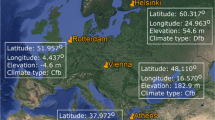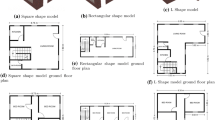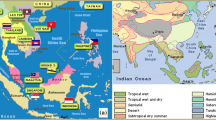Abstract
The member states of the European Union must increase the energy efficiency in residential buildings within the plan to reduce the external energy dependence and energy shortage. In the present work, a standard building representative of the existing buildings in Spain built before 1980 was used. An evaluation of the energy rating of that building in each climatic zone of Spain was carried out to assess the influence of these climatic conditions on energy consumption and greenhouse gas emissions. This analysis was carried out with Cerma software according to the calculation procedure demanded by the Spanish Building Technical Code. Results show that E or F energy score was obtained for the different climatic zones and with significant differences in CO2 emissions, even for climatic zones with the same energy rating. A sensitivity study of the necessary enhancements in each climatic zone was carried out to analyze the influence of most common energy demand and thermal system improvements, and combinations of them. Also, the minimum requirements to obtain D qualification in each Spanish climatic zone were obtained. As a result, it is possible to reduce emissions in Spain by over 3.5 Mt CO2 per year. In climatic zones with initial qualification E, it is possible to reach a D label, avoiding 40% of the initial CO2 emissions and reducing primary energy consumption to about 50 kWh/m2 year (over 60% reduction). For the climatic zones with initial qualification F, over 53% of the initial CO2 emissions are avoided by reaching D label. Zones with the highest heating demand (over 230 kWh/m2 year) and very low cooling demand need to improve thermal systems by means of a heat pump. Finally, some policy measures to create lines of financial aids or subsidies for the implementation of actions to reduce energy demand in Spanish homes are proposed.
Graphic abstract









Similar content being viewed by others
Abbreviations
- I 0 :
-
CO2 emissions generated by the building (kg CO2/m2 year)
- I r :
-
Average CO2 emissions from residential buildings strictly meeting CTE requirements (kg CO2/m2 year)
- I S :
-
Average CO2 emissions from existing residential buildings in 2006 (kg CO2/m2 year)
- nr:
-
Air renewals
- R :
-
Ratio between CO2 emissions of 50th and 10th percentiles in residential buildings strictly meeting BTC requirements
- R′:
-
Ratio between CO2 emissions of 50th and 10th percentiles in existing residential building stock
- U :
-
Thermal transmittance (W/m2 K)
- λ :
-
Thermal conductivity (W/m2 K)
- σ 1 :
-
First energy efficiency rating index
- σ 2 :
-
Second energy efficiency rating index
- Bio:
-
Biomass
- BREEAM:
-
Building Research Establishment Environmental Assessment Method
- BTC:
-
Building Technical Code
- COP:
-
Coefficient of performance
- DHW:
-
Domestic hot water
- EEOnt:
-
Energy efficiency ontology
- EER:
-
Energy efficiency ratio
- EESs:
-
Energy efficiency services
- EU:
-
European Union
- GHG:
-
Greenhouse gases
- HP:
-
Heat pump
- IDAE:
-
Institute for Energy Diversification and Saving
- IEA:
-
International Energy Agency
- INE:
-
National Statistics Institute
- LEED:
-
Leadership in Energy and Environmental Design
- LPG:
-
Liquefied petroleum gas
- MINETUR:
-
Ministry of Industry, Energy and Tourism
- MSF:
-
Modified solar factor
- NBC:
-
National Building Code
- NEEAP:
-
National Energy Efficiency Action Plan
- NG:
-
Natural gas
- RBHI:
-
Regulations on Building Heating Installations
- RD:
-
Royal decree
- SB:
-
Standard building
- SF:
-
Solar factor
- TI:
-
Thermal insulation
- CO2 :
-
Carbon dioxide
References
Andaloro AP, Salomone R, Ioppolo G, Andaloro L (2010) Energy certification of buildings: a comparative analysis of progress towards implementation in European countries. Energy Policy 38:5840–5866
Bagheri F, Mokarizadeh V, Jabbar M (2013) Developing energy performance label for office buildings in Iran. Energy Build 61:116–124
Borgstein EH, Lamberts R, Hensen JLM (2016) Evaluating energy performance in non-domestic buildings: a review. Energy Build 128:734–755
Carpio M, Martín-Morales M, Zamorano M (2015) Comparative study by an expert panel of documents recognized for energy efficiency certification of buildings in Spain. Energy Build 99:98–103
Cerma (2017) Certificación de Eficiencia Energética de Edificios de viviendas nuevos y existentes. Cerma software v.4.2.5
Chandel SS, Sharma A, Marwaha BM (2016) Review of energy efficiency initiatives and regulations for residential buildings in India. Renew Sustain Energy Rev 54:1443–1458
Cuchí A (2016) Diagnóstico de la rehabilitación en Comunidades Autónomas. Fundación CONAMA, Madrid. ISBN: 978-84-617-4203-5
De Boeck L, Verbeke S, Audenaert A, De Mesmaeker L (2015) Improving the energy performance of residential buildings: a literature review. Renew Sustain Energy Rev 52:960–975
Directive 2012/27/EU of the European Parliament and Council on Energy Efficiency, amending Directives 2009/125/EC and 2010/30/EU and Repealing Directive 2004/8/EC and 2006/32/EC. Official J Eur Union Brussels, Belgium, October 2012
European Commission (2011) Energy efficiency plan 2011. COM109. Brussels
European Commission (2019) Energy topics. https://ec.europa.eu/energy/en/topics/energyefficiency/bui. Accessed 20 August 2019
European Directive 2010/31/EU of the European Parliament and of the Council, on the Energy Performance of buildings. https://eur-lex.europa.eu/LexUriServ/LexUriServ.do?uri=OJ:L:2012:315:0001:0056:en:PDF. Accessed 20 August 2019
Eurostat (2019) Energy balances: final energy consumption by sector. https://ec.europa.eu/eurostat/web/energy/data/energy-balances. Accessed 20 August 2019
Gaglia AG, Dialynas EN, Argiriou AA, Kostopoulou E, Tsiamitros D, Stimoniaris D, Laskos KM (2019) Energy performance of European residential buildings: energy use, technical and environmental characteristics of the Greek residential sector-energy conservation and CO2 reduction. Energy Build 183:86–104
Gamalath I, Hewage K, Ruparathna R, Karunathilake H, Prabatha T, Sadiq R (2018) Energy rating system for climate conscious operation of multi-unit residential buildings. Clean Technol Environ Policy 20(4):785–802
Gangolells M, Casals M, Forcada N, Macarulla M, Cuerva E (2016) Energy mapping of existing building stock in Spain. J Clean Prod 112:3895–3904
Harris DJ (1999) A quantitative approach to the assessment of the environmental impact of building materials. Build Environ 34(6):751–758
Heidarinejad M, Dahlhausen M, McMahon S, Pyke C, Srebric J (2014) Cluster analysis of simulated energy use for LEED certified US office buildings. Energy Build 85:86–97
Hossaini N, Hewage K, Sadiq R (2015) Spatial life cycle sustainability assessment: a conceptual framework for net-zero buildings. Clean Technol Environ Policy 17(8):2243–2253
Hu M, Qiu Y (2019) A comparison of building energy codes and policies in the USA, Germany, and China: progress toward the net-zero building goal in three countries. Clean Technol Environ Policy 21(2):291–305
Instituto para la Diversificación y Ahorro de la Energía (IDAE) (2011) Proyecto SECH-SPAHOUSEC Análisis del consumo energético del sector residencial en España. https://www.idae.es/uploads/documentos/documentos_Informe_SPAHOUSEC_ACC_f68291a3.pdf. Accessed 20 August 2019
Instituto para la Diversificación y Ahorro de la Energía (IDAE) (2016) PROGRAMA PAREER-CRECE. https://www.idae.es/ayudas-y-financiacion/para-rehabilitacion-de-edificios-programa-pareer/programa-de-ayudas-para-la. Accessed 20 August 2019
International Energy Agency (IEA) (2010) Energy Performance Certification of Buildings. A policy tool to improve energy Efficiency. OECD/IEA, Paris
Labanca N, Suerkemper F, Bertoldi P, Irrek W, Duplessis B (2015) Energy efficiency services for residential buildings: market situation and existing potentials in the European Union. J Clean Prod 109:284–295
Martínez-Molina A, Tort-Ausina I, Cho S, Vivancos JL (2016) Energy efficiency and thermal comfort in historic buildings: a review. Renew Sustain Energy Rev 61:70–85
Milutienė E, Staniškis JK, Kručius A, Augulienė V, Ardickas D (2012) Increase in buildings sustainability by using renewable materials and energy. Clean Technol Environ Policy 14(6):1075–1084
Ministerio de Fomento (Gobierno de España) (2014) Estrategia a largo plazo para la rehabilitación energética en el sector de la Edificación en España. https://www.fomento.gob.es/el-ministerio/planes-estrategicos/estrategia-a-largo-plazo-para-la-rehabilitacion-energetica-en-el-sector-de-la-edificacion-en-espana. Accessed 20 August 2019
Ministerio de Fomento (Gobierno de España) (2019) Código Técnico de la Edificación (CTE, in English BTC). https://www.codigotecnico.org/. Accessed 20 August 2019
Ministerio de Industria, Energía y Turismo (Gobierno de España) (2011) Instituto para la Diversificación y Ahorro de Energía (IDAE). Escala de Calificación energética de edificios existentes y Edificios de nueva construcción. IDAE, Madrid
Ministerio de Industria, Energía y Turismo (Gobierno de España) (2014) Plan Nacional de Acción y Eficiencia Energética 2014–2020 (NEEAP 2014–2020). Madrid. Spain. https://www.idae.es/tecnologias/eficiencia-energetica/plan-nacional-de-accion-de-eficiencia-energetica-2017-2020. Accessed 20 August 2019
Pérez-Lombard L, Ortiz J, González R, Maestre IR (2009) A review of benchmarking, rating and labelling concepts within the framework of building energy certification schemes. Energy Build 41(3):272–278
Poel B, Van Cruchten G, Balaras CA (2007) Energy performance assessment of existing dwellings. Energy Build 39:393–403
Real Decreto 1027/2007, de 20 de julio, por el que se aprueba el Reglamento de Instalaciones Térmicas en los Edificios, (RITE). https://www.boe.es/buscar/doc.php?id=BOE-A-2007-15820. Accessed 20 August 2019
Real Decreto 235/2013, de 5 de abril, por el que se aprueba el procedimiento básico para la certificación de la eficiencia energética de los edificios. https://www.boe.es/buscar/act.php?id=BOE-A-2013-3904. Accessed 20 August 2019
Real Decreto 314/2006, de 17 de marzo, por el que se aprueba el Código Técnico de la Edificación (BTE, in Spanish CTE). https://www.boe.es/buscar/doc.php?id=BOE-A-2006-5515. Accessed 20 August 2019
Ríos JC (2019) A novel integrated waste energy reroofy system (IWERS) by thermal flows: a supermarket sector case. Sustain Prod Consum 19:97–104
Salleh MNM, Kandar MZ, Sakip SRM (2016) Benchmarking for energy efficiency on school buildings design: a review. Proc Soc Behav Sci 222:211–218
Scofield JH (2013) Efficacy of LEED-certification in reducing energy consumption and greenhouse gas emission for large New York City office buildings. Energy Build 67:517–524
Silvero F, Rodrigues F, Montelpare S, Spacone E, Varum H (2019) The path towards buildings energy efficiency in South American countries. Sustain Cities Soc 44:646–665
Terés-Zubiaga J, Campos-Celador A, González-Pinoa I, Escudero-Revilla C (2015) Energy and economic assessment of the envelope retrofitting in residential buildings in Northern Spain. Energy Build 86:194–202
Trashorras AJ, González JM, Álvarez E, Sánchez JP (2015) Certification of energy efficiency in new buildings: a comparison among the different climatic zones of Spain. IEEE Trans Ind Appl 51(4):2726–2731
US Green Building Council (2013) LEED 2009 for schools new construction and major renovations rating system. Green Building Council, Washington
Vinagre JJ, González JM, Wilby MR, Rodríguez AB, García J (2013) EEOnt: an ontological model for a unified representation of energy efficiency in buildings. Energy Build 60:20–27
Author information
Authors and Affiliations
Corresponding author
Additional information
Publisher's Note
Springer Nature remains neutral with regard to jurisdictional claims in published maps and institutional affiliations.
Rights and permissions
About this article
Cite this article
Ríos Fernández, J.C., González-Caballín, J.M. & Gutiérrez-Trashorras, A.J. Effect of the climatic conditions in energy efficiency of Spanish existing dwellings. Clean Techn Environ Policy 22, 211–229 (2020). https://doi.org/10.1007/s10098-019-01778-x
Received:
Accepted:
Published:
Issue Date:
DOI: https://doi.org/10.1007/s10098-019-01778-x




